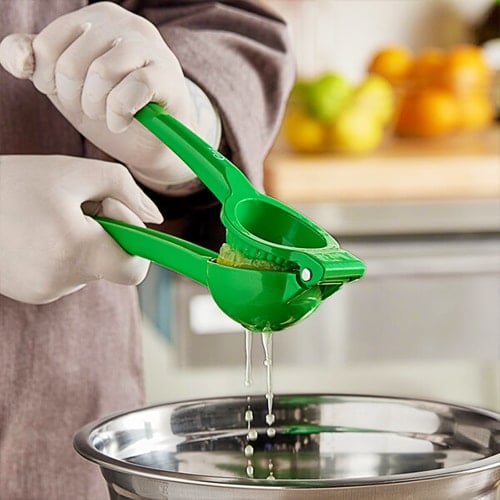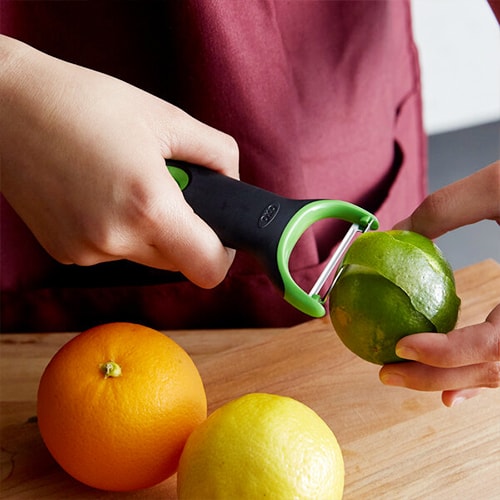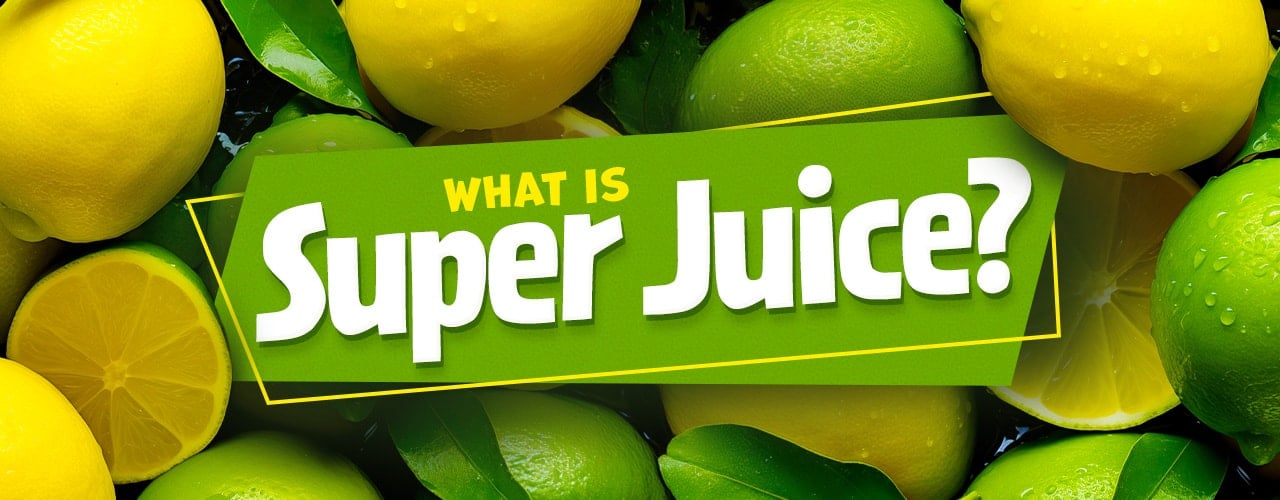Super juice isn't a wellness fad or a green juice recipe; it's a method of extending your fresh citrus juice so that you get more for your money. Usually, citrus peels are tossed out in the trash. With super juice, the peels are combined with the juice to create a sustainable cocktail ingredient. This bartending hack is a cost-effective way to extend your fresh produce while saving time behind the bar. Keep reading to learn more about super juice and how you can make your own.
What Is Super Juice?

Super juice, also called oleo citrate, is an emulsification of citrus juice, peels, citric acid, malic acid, and water. It may sound scientific, but the result is a great-tasting citrus product that gives you up to 8 times more juice than squeezing or pressing alone. It also lasts a week or more in the fridge, which makes it a convenient bar ingredient to use for cocktails. Super juice can be used in margaritas or any beverage that features fresh citrus juice. Keep in mind that super juice is a fresh juice product with a high-quality citrus flavor. It's not the same thing as bottled lime juice that contains preservatives, even though it provides the same benefits, like a long shelf-life.
What Are Malic Acid and Citric Acid?
Two of the ingredients used to make super juice are malic acid and citric acid. These crystalline powders have a sour and acidic taste that makes them ideal flavor enhancers. Citric acid is commonly used as a preservative, baking ingredient, and candy coating. You can purchase citric acid where you buy wholesale spices. Malic acid is often used in the production of beverages such as fruit juices, energy drinks, and sodas. It helps to provide a refreshing tartness and can enhance the overall flavor profile of the drink. Shop for malic acid online or at specialty stores. Both citric acid and malic acid are key components to making super juice.
Who Invented Super Juice?
Bartenders and mixologists have been playing around with methods of preserving lime juice for several years. The collective knowledge of these pioneers has resulted in the discovery of super juice in different forms. Nickle Morris, a Kentucky-based bartender and owner introduced his recipe for super juice in a YouTube video in 2020. Since then, many videos with variations on the recipe have followed. Even though no one is gatekeeping this recipe, super juice remains a bit of an industry secret. We think it deserves to be shared with all bartenders because it's truly a game-changer.
Why Should I Try Super Juice?

Now that you know what it is and where it comes from, you may be wondering why super juice is so special. Here are a few reasons you should try super juice for yourself:
- Fresh Flavor: Unlike bottled juice products, super juice preserves the fresh flavor of the juice, which is very different than bottled juices that contain sulfites. Bottled pasteurized lime juice has its place and comes in handy for a range of recipes, but when you're crafting a cocktail, the flavor of fresh citrus is incomparable. It shines through, simultaneously enhancing and balancing the drink.
- Affordability: If you're looking for ways to cut food cost, you've found one. Fresh produce can be an expensive part of your budget, and with super juice, you get more juice with less product.
- Sustainability: Peels and rinds account for a large portion of the waste material from citrus fruits that makes it to the landfill. Instead of creating more food waste, you can use citrus peels to make super juice.
- Shelf-Life: Fresh lime juice or lemon juice has to be used within a couple of days, but super juice can last up to 10 days. If you make a large batch of super juice and freeze it, it can last even longer. This is extremely convenient for bartending and helps you skip the juicing step.
Super Lime Juice Recipe

You can make super juice from any type of citrus, and you only need a few tools: an immersion blender, a citrus peeler, and a citrus squeezer. Our recipe below is for limes since lime juice is a common bartending essential.
Yield: 4 cups
Prep Time: 75 minutes
Ingredients
- 8 limes
- 44 grams citric acid
- 8 grams malic acid
- 4 cups water
Directions
- Peel limes and add peels to large container.
- Add citric acid and malic acid to container.
- Muddle peel mixture with muddler or back of large spoon.
- Let mixture sit for one hour.
- Meanwhile, juice all peeled limes and set aside.
- After one hour, add juice and water to peel mixture and blend with immersion blender until smooth.
- If preferred, use fine strainer to remove solids.
- Refrigerate super juice mixture for up to 7-10 days.
- Use in place of lime juice in any cocktail!
Can You Make Super Juice with Lemons?
Yes, you can adapt this recipe for any type of citrus, including lemons. Just swap out the 8 limes in the recipe above for 6 lemons and proceed with the same directions.
Can You Freeze Super Juice?
Yes, you can freeze super juice to make it last even longer. Place the juice in a freezer-safe container and freeze for up to 6 months.
Instead of squeezing lemons and limes for every drink, try making a batch of super juice. You'll save time, money, and effort while crafting delicious cocktails with bright citrus flavors. Super juice can be added to margaritas, mojitos, and any drink that features lemon or lime juice.
Related Resources

What Is Cold-Pressed Juice?
Unlike traditional juicing methods that use high-speed blades to extract juice, cold-pressed juice is made by pressing and squeezing fruits and vegetables. This gentle extraction process helps to preserve the maximum amount of vitamins, minerals, and enzymes found in the produce. With its numerous health benefits and delicious flavors, it's no wonder that cold-pressed juice has gained popularity among health-conscious individuals and commercial establishments alike. Read on to discover everything you need to know about this trendy type of juice and how your business can integrate it into your menu. Shop All Juice Products Use these links to learn more about cold-pressed juice: What Is a Cold Press? How to Cold Press Juice Is Cold-Pressed Juice Good for You? Cold-Pressed Juices Shelf Life of Cold-Pressed Juice Cold Press Juice vs Normal Juice Cold-Pressed Juice Video To learn about the features and benefits of cold-pressed juices, watch the video below. <iframe itemprop="embedURL" width="560" height="315" src="https://www.youtube.com/embed/hFhIvmWQpWE?si=53onb4uOGp1LNYsk?rel=0" frameborder="0" allowfullscreen></iframe> What Is a Cold Press? A cold press is a type of juicer that uses hydraulic pressure to extract juice from fruits and vegetables. Unlike traditional juicers relying on high-speed blades or centrifugal force, cold press juicers operate much slower. While other juicers generate heat during the extraction process, cold press juicers use a hydraulic press to squeeze the juice out of the produce. This minimal heat exposure ensures that the juice's nutrients, enzymes, and vitamins remain intact. How to Cold Press Juice To cold press juice, you will need a cold press juicer, also known as a masticating juicer. Cold press juicers use a slow, grinding motion to extract juice from fruits and vegetables, resulting in a vibrant and nutritious product. By following these steps, you can create your own cold-pressed juices, ensuring a healthy and refreshing beverage option for your commercial establishment: Prepare Your Ingredients - To begin, select the fruits and vegetables you want to juice. It's important to use fresh, high-quality produce to ensure the best flavor and nutritional value. Wash and peel your ingredients as needed, removing any seeds or tough stems. Slice Produce - Next, cut your fruits and vegetables into smaller pieces that will fit into your juicer. Different fruits and vegetables may require different cutting techniques, so be sure to follow the specific instructions for each ingredient. Assemble Your Cold Press Juicer - Now it's time to set up your cold press juicer. This involves attaching the juice container, placing the pulp container, and securing the juicing mechanism. Start Juicing - Once your juicer is fully assembled, begin feeding the prepared ingredients into the machine. Use the plunger or pusher provided with your juicer to slowly and gently press the produce into the juicing mechanism. Collect the Juice - As the juice is extracted, it will flow into the juice container. You can use a separate container or a glass to collect the juice. Separate the Pulp - After juicing, you'll be left with a pulp residue. This can be collected in a separate container or discarded, depending on your preference. Cold Press Equipment and Tools To properly make cold-pressed juice, a variety of tools and equipment are required to extract the full nutrient and flavor profile of the fruit. With the right setup, cold pressing juices become a simple and efficient task, allowing you to handle a high volume of orders. Below, we’ll cover the necessary equipment and tools you'll need to get started and how to use each tool in the cold pressing process: Cold Press Juicer - This specialized machine is designed to extract juice using a hydraulic press. Look for a juicer that fits your budget and meets your specific requirements. Cutting Board and Knife - A sturdy cutting board and a sharp knife are essential for prepping your ingredients. Ensure that your knife is sharp enough to cut through tough fruits and vegetables with ease. Containers - You'll need containers to collect the juice and separate the pulp. Glass or BPA-free plastic containers are popular choices for storing cold-pressed juice. Plunger or Pusher - Most cold press juicers come with a plunger or pusher to help feed the ingredients into the juicing mechanism. This tool ensures safe and efficient juicing. Back to Top Is Cold-Pressed Juice Good for You? Cold-pressed juice is known for its high concentration of vitamins and antioxidants. Compared to other types of juice, cold-pressed juice often contains more fiber. The hydraulic press used in the cold press extraction process helps to extract juice from the entire fruit or vegetable, including the pulp and skin. This means that the resulting juice retains more fiber, aiding digestion and promoting feelings of fullness. Benefits of Cold-Pressed Juice Cold-pressed juice offers a range of benefits that can support your overall health and well-being. From providing essential nutrients to aiding digestion and promoting detoxification, these refreshing beverages are a great addition to a healthy lifestyle. Let’s take a look at some of the reported health benefits of consuming cold-pressed juices: Antioxidants - One of the key benefits of cold-pressed juices is their high concentration of antioxidants. Cold-pressed juices retain more antioxidants compared to other juicing methods, as the low heat and slow extraction process help preserve the nutrients. Anti-Inflammatory Properties - Cold-pressed juices, especially those made with ingredients like turmeric, ginger, and leafy greens, contain natural compounds that can help reduce inflammation in the body and promote overall wellness. Improved Digestion - Cold-pressed juices are often made with a combination of fruits, vegetables, and herbs that are rich in fiber, enzymes, and other digestive aids. These nutrients can help support a healthy gut by promoting and improving nutrient absorption. Boosted Immune System - Many fruits and vegetables used in cold-pressed juices, such as oranges, lemons, and leafy greens, are packed with immune-boosting vitamins and minerals. Regularly consuming cold-pressed juices can help strengthen your immune system, making you less susceptible to common illnesses and infections. Cold-Pressed Juices Although there are a variety of combinations you can experiment with when creating cold-pressed juices, there are a handful of common types that do best in a commercial setting. These juices are a spin-off of classic juice flavors, allowing customers to enjoy their favorite flavors while reaping the benefits of cold-pressed juices. If you’re considering adding cold-pressed juice to your menu, consider using the following juices to attract the most customers: Cold-Pressed Orange Juice - Made from freshly squeezed oranges, this juice is packed with vitamin C and other essential nutrients. It's a refreshing and tangy beverage that can be enjoyed on its own or used as a base for smoothies and cocktails Cold-Pressed Green Juice - This vibrant and detoxifying beverage is typically made with a combination of leafy greens like kale, spinach, and arugula, along with other ingredients like apples, ginger, and lemon. Cold-pressed green juice is an excellent way to boost your daily intake of vitamins, minerals, and antioxidants, all while promoting overall health and well-being. Cold-Pressed Lemonade - Made with freshly squeezed lemons, this tangy beverage is perfect for quenching your thirst on a hot summer day. Cold-pressed lemonade can also be customized with other fruits or herbs to add an extra twist of flavor. Cold-Pressed Carrot Juice - Carrots are rich in beta-carotene, which is converted to vitamin A in the body. This juice is not only refreshing but also provides a host of health benefits, including improved eye health and a strengthened immune system. Shelf Life of Cold-Pressed Juice Shelf life refers to the length of time that a product can be stored before it begins to deteriorate in quality or become unsafe to consume. The shelf life of cold-pressed juices typically ranges from three to five days when stored properly under refrigeration. That being said, there are a variety of factors that can extend or decrease the shelf life of a cold-pressed juice: Cold-Pressed Ingredients The shelf life of cold-pressed juice largely depends on the ingredients used. Some fruits and vegetables have a longer shelf life than others. For example, citrus fruits like oranges and lemons tend to last longer, while leafy greens like spinach and kale have a shorter lifespan. Additionally, the quality and freshness of the produce used can impact the juice's overall shelf life. Processing Method Cold-pressed juice is made using a hydraulic press that extracts the juice from fruits and vegetables without heat, preserving more nutrients and enzymes. This gentle extraction process helps extend the shelf life of the juice compared to traditional juicing methods. However, the shelf life can still be affected by factors like temperature and exposure to air during the juicing process. Pasteurization While cold-pressed juice is typically unpasteurized to retain its nutritional value, some manufacturers opt for a process known as high-pressure processing (HPP). HPP uses pressure to kill harmful bacteria and extend the shelf life of the juice. Pasteurized cold-pressed juice may have a longer shelf life but could also lose some of its nutritional benefits in the process. Back to Top Storing Cold-Pressed Juices Cold-pressed juices spoil faster compared to their pasteurized counterparts. This is because the absence of heat during the extraction process leaves the juices more vulnerable to spoilage and oxidation. Therefore, proper storage techniques are essential to preserve the nutritional value and extend the shelf life of your cold-pressed juices. Below, we cover some of the best ways to store and use cold-pressed juices to ensure you get maximum freshness and flavor: Refrigeration Cold-pressed juice is highly perishable and should be refrigerated at all times. The cold temperature helps slow down the growth of bacteria and enzymes that can cause spoilage. Keep your juice stored below 41°F (5°C) to maintain its freshness for as long as possible. Use Air-Tight Containers Oxygen is the worst enemy of fresh juice. Once exposed to air, the juice can oxidize and lose its nutritional value. Store your cold-pressed juice in airtight containers, such as glass bottles or jars with tight-fitting lids, to minimize contact with air and extend its shelf life. Separate Different Juices Consider storing different flavors separately. Mixing different juices can accelerate spoilage, as certain fruits and vegetables have shorter shelf lives. By storing them separately, you can enjoy each flavor at its freshest. Consume within a Few Days While the shelf life of cold-pressed juice can vary depending on the factors mentioned above, it's generally recommended to consume it within three to five days of juicing. This timeframe ensures that you're getting the maximum nutritional benefits and flavor from your juice. Cold Press Juice vs Normal Juice Both types of juice provide a convenient way to consume fruits and vegetables, they differ significantly in terms of production methods and nutritional content. While cold-pressed juice is often considered the healthier choice due to its gentle extraction process and higher nutrient content, other types of juice offer convenience and a longer shelf life. Discover the differences between cold-pressed juice and other types of juices below: Nutritional Benefits - Since the hydraulic press method does not generate heat, the enzymes, vitamins, and minerals found in the fruits and vegetables remain intact. In contrast, the heat generated during the centrifugal juicing process used in normal juicing can cause some loss of nutrients. Shorter Shelf Life - The high-pressure extraction process eliminates most of the oxygen, which helps to preserve the juice and prevent oxidation. However, the lack of heat from the pasteurization process means that cold-pressed juices often spoil faster than their pasteurized counterparts. Vibrant Taste - Due to the careful extraction process, cold-pressed juice often has a more intense and natural flavor compared to regular juice. The combination of fresh, high-quality ingredients and the absence of heat allows the true essence of the fruits and vegetables to shine through. Whether you run a cafe, juice bar, or restaurant, incorporating cold-pressed juice into your menu can add a touch of freshness and vitality to your beverage selection. With a wide range of fruit and vegetable combinations available, businesses can create unique and flavorful juice blends to cater to their customer's preferences. More consumers are seeking out nutritious alternatives to sugary sodas and artificially flavored drinks, so offering cold-pressed juice can attract health-conscious customers and differentiate your establishment from the competition.

How to Start a Juice and Smoothie Bar
Juice and smoothie bars used to attract only the most health-conscious consumers, but their mass appeal has grown due to an increased interest in wellness. Healthy living and nutritious diets are more popular than ever. For some, a daily visit to the local juice bar has become as routine as a trip to the corner coffee shop. If you’re interested in opening your own juice bar or smoothie shop, check out our juice bar startup guide. Shop All Commercial Juicers Click on any of the juice bar opening steps below to learn more: Juice Bar Concept Juice Bar Business Plan Obtain Juice Bar Funding Juice Bar Location Juice Bar Permits and Licenses Juice Bar Equipment and Supplies Hire Juice Bar Staff Advertise Your Juice Bar Host a Juice Bar Soft Opening Juice Bar FAQs What Is a Juice Bar? A juice bar is a shop that sells fruit and vegetable juices that are freshly squeezed on the premises. Most juice shops occupy a small footprint because they don't require a full kitchen or a seating area. Kiosks, juice carts, and juice food trucks are all popular models for a juice and smoothie shop. The rising popularity of healthy juices and the low start-up cost make juice shops an appealing business venture. Open a Juice Bar The process of opening your own juice bar and smoothie shop is much easier when you break it down into steps. We've created a 9-step juice bar guide to help you get started. 1. Choose a Juice Bar Concept and Brand Choosing the concept of your juice bar is the starting point in your journey. It’s also the most creative step along the way. You get to choose the theme of your shop, the types of ingredients you’ll use, and the way you’ll serve your customers. Check out these examples of juice bar concepts: Mobile juice bar cart specializing in organic produce, vitamin supplements, and health tonics Cafe-style juice bar with a food menu and co-working space Smoothie shop with a build-your-own makeline where customers choose their smoothie base, ingredients, and add-ins After you have a basic idea of your concept, you can work out the finer details of your brand. Your juice bar name, logo, menu options, and menu design are all part of your company branding and should communicate the same message. Juice Bar Menu There are many avenues you can take with your juice bar menu. You can keep it simple and stick to fresh cold-pressed juices only. Or you could get creative with different juice combinations and highlight a tropical fruit of the day. Some juice bars include blended smoothies and smoothie bowls. You may also decide to offer a small food menu with healthy salads and sandwiches. Make sure to consider your staffing requirements and the types of equipment you’ll need to produce certain menu items. 2. Write a Juice Bar Business Plan Writing a business plan is the next step in the process of opening your juice bar. Don’t skip the business plan, even if you think you have all the details of your business memorized. It’s a professional way to gather all your important info in one place and present the idea to potential investors. Your juice bar business plan should contain the following sections: Executive Summary - Write this section last and use it to summarize the business plan as a whole. Company Overview and Description - Include a detailed overview of your juice bar business. Concept and Menu - In this section, describe all the details of your juice bar concept and menu. Management and Ownership Structure - This section should explain the hierarchy of your management structure. Employees and Staffing Needs - List out all staff positions and the number of employees needed for operation. Marketing and Competitor Analysis - Perform research on local competitors and provide an analysis of your findings in this section. Advertising and Marketing Strategies - Outline the types of advertising and marketing strategies you’ll use for your juice bar. Financial Projection and Summary - Use this section to provide a sales forecast and break-even analysis. If you want to learn more about writing business plans, check out our comprehensive restaurant business plan guide. 3. Obtain Juice Bar Funding When you officially obtain funding for your juice bar, your vision starts to become a reality. This part of the process can be intimidating if you’ve never started a business, but after you’ve written a business plan, you’ll have a better idea of your startup costs. Compare your total startup costs to the amount of capital you have on hand. After you determine the balance, you’ll know how much funding you need to open your juice bar. Don’t forget to include the working capital needed to operate the juice bar until you start turning a profit. Small Business Loan - The Small Business Association (SBA) works with lenders to make it easier for small businesses to get loans. SBA-approved loans offer unique benefits like lower down payments and capped interest rates. Traditional Commercial Loan - A traditional commercial loan is typically larger than a small business loan. Because the loan amount is greater, lenders usually have a stricter application process and require that your business bring in higher revenues. Business Line of Credit - A business line of credit is similar to a credit card. Instead of a lump sum, borrowers receive a line of credit to use for expenses as they come up. Access to short-term funding like this is most helpful with operational expenses. Crowdfunding - Crowdfunding has become a legitimate method to raise funds for your business. There are several platforms that allow you to create a campaign and start accepting donation-based or rewards-based contributions. For in-depth financial information, check out our restaurant funding and loans guide. 4. Choose a Juice and Smoothie Shop Location Your juice bar location and business concept should go hand in hand. Sometimes choosing your location ends up being the first step in the process of opening your business. You might have your eye on a commercial space that speaks to you, or maybe you got a great deal on leasing a juice bar kiosk. If that’s the case, you should base the concept of your shop on your chosen location. For example, if the location is in a college town, you’ll want to create a concept that appeals to a young crowd. If you have your heart set on a particular concept, you’ll need to find a juice bar location that can support it. Look for locations near gyms or in neighborhoods with jogging paths and outdoor spaces. Boardwalks, beach towns, and charming main streets are great for juice bars and smoothie shops. Performing a location analysis will help you understand the benefits and limitations of specific locations. 5. Obtain Permits and Licenses for Your Juice Shop Before your juice bar can open for business, you’ll need to obtain several permits and licenses at the federal, state, and local levels. Enlisting the help of legal counsel ensures you won’t miss a step when filing for new permits. Business License - Every new business needs a business license to operate legally in the US. Each state has its own business license requirements. Employee Identification Number - You need an Employee Identification Number (EIN) to start hiring employees and set up your payroll. The application process can be lengthy, so start working on this one right away. Foodservice License - To legally serve food, you’ll need a foodservice business license. This requires an inspection that shows your business meets food safety protocols. Learn more about foodservice permits in our restaurant licenses guide. 6. Juice Bar Equipment and Supplies Juice bars have unique inventory needs because fresh produce will make up the bulk of your food orders. That means you’ll need to find a high-quality wholesale produce supplier. Look for distributors that can supply you with local seasonal produce, but you may also need a different supplier for fruits that don’t grow locally. You’ll want to consider these factors when choosing a produce supplier: Produce Selection - Some suppliers specialize in citrus fruits only while others provide a wide selection Fair Trade Certified - Look for suppliers that only work with fair trade certified growers Farming Practices - If organic, pesticide-free produce is part of your concept, you’ll need to find a supplier that can meet these needs Specialty Items - Depending on your location, you may need to find suppliers to provide you with specialty, tropical produce With fresh produce also comes the need for specialized storage techniques. Understanding the shelf-life of certain fruits will be key to your reordering schedule. Some fruits need refrigeration, and some fruits need to be washed prior to storage. Check out our produce storage guide for detailed information. Your juice bar will need to be outfitted with the right equipment for storing, prepping, and juicing fresh fruits. Commercial juicers are the obvious place to start, but there are several types of juicers designed for different applications. Here is a list of juice bar equipment and supplies you'll need to get started: Juicers - Centrifugal, masticating, citrus, and wheatgrass juicers Blenders - High-powered blenders with sound enclosures Food Prep - Peelers, chef knives, and cutting boards Refrigeration - Refrigerated storage for produce, glass case merchandisers for bottled juices Ice Machines - Ice machines that produce enough ice for your blended drinks Cups, Bowls, Lids, Straws - Eco-friendly disposables for serving juices, smoothies, and smoothie bowls 7. Hire Juice Bar Staff Labor cost for a juice bar is relatively low compared to other foodservice businesses because a small staff is sufficient to run the shop. For a small juice bar kiosk, one or two employees may be all you need. Bigger locations that serve more than one guest at a time will need a larger staff. Also, consider that on truck receiving days you may need to schedule extra employees to inspect and put away produce shipments. Outside of your juice bar staff, you might also employ other professionals to run your website or handle your accounting. Here are some ways to attract possible candidates for your new juice bar: Write a Great Job Description - It might seem obvious, but the job description you write goes a long way to attracting the type of candidate you are looking for. Put some thought into the description and make sure it conveys your values and company mission. Social Recruiting - Many folks in the workforce use the social platform LinkedIn to search for jobs. Create a LinkedIn profile and take advantage of the recruiting features the site offers. Job Search Websites - Make a job listing on popular search engines like Indeed, Monster, and SimplyHired. Go Old School - Believe it or not, posting jobs in the newspaper or just putting up a “Now Hiring” sign on your storefront are still options that work. 8. Advertise Your Juice Bar Advertising your new juice bar is how you let the public know you are open and ready for business. Today, digital methods of advertising are extremely important if you want to reach a wide audience. It’s very easy to advertise your business online and you can start doing it early on to build excitement for your brand. Check out our tips for marketing your new juice bar: Build a Website - You absolutely must have a website if you own a business. Thankfully, you don’t have to be an expert to put together a user-friendly website. Platforms like Squarespace and WordPress help you design an attractive site and are very easy to use. Increase Your Digital Presence - Register your business with online platforms like Google My Business, OpenTable, or Trip Advisor. This increases your online presence and helps you connect with potential customers. Create a Blog - Add a blog section to your website to help search engines recognize your business and build awareness around your brand. Since juicing is your realm of expertise, create a blog that’s devoted to juicing. Cover topics like juicing benefits, the best fruits and vegetables for juicing, or how to use commercial juicers. Use Social Media - Just like a company website, your social media accounts are a crucial part of advertising in the digital age. You can choose to set up company profiles on all platforms, or take a more systematic approach by zeroing in on the platforms that your target customers use. 9. Juice Bar Soft Opening Before your official grand opening, it can be helpful to plan a practice run. A soft opening is a modified opening that gives your team the opportunity to test out the flow of service. You can observe potential hiccups and get a better idea of what processes may need to be improved before the big grand opening. Here are some tips for planning a soft opening of your juice bar: Friends and Family Night - Invite friends and family of your staff for a sneak peek opening. It’s a good way to ease into things because there’s less pressure when you know all the guests. Neighborhood Meetup - Send soft opening invites to neighboring businesses and residents. You get to meet all your neighbors and get the word out in your community. Limited Menu - For your soft opening, it can be helpful to start with a small limited menu. Instead of offering all juices on your menu, you could showcase three different juices. It’s less stressful for your employees when you start small. Juice Bar FAQS We cover some of the most common juice bar questions below: How Much Does it Cost to Start a Juice Bar? The average startup cost for a juice bar, not including operational cost, is between $25,000 and $400,000. The reason for this wide range is that the location, build-out expenses, and store size are different for every juice shop. If you lease an existing space that requires little remodeling, your cost will be on the low side. On the other end of the spectrum, a complete remodel of your space will be much more expensive. These are some of the factors that affect your startup costs: Franchise or Independent - Popular juice and smoothie franchises, like Smoothie King or Jamba Juice, can provide built-in branding and recognition for your new business if you choose that route. But franchise fees will increase your startup costs and you'll have to pay ongoing royalties. If you go independent, you avoid these extra costs. Juice Cart, Kiosk, or Juice Truck - Juice bars by nature don't require a lot of square footage. Instead of a brick and mortar, consider a mobile business like a juice cart or food truck. Your startup costs will be much lower with a mobile or kiosk-style location than with a traditional storefront. Sell Juice From Home - There's a wave of entrepreneurs starting businesses from their homes. With the right permits and inspections, you can turn your kitchen into a juice factory and sell your products online or at local markets. Are Juice Bars Profitable? Yes, juice bars have the potential to be very profitable. It's reported that the average revenue of a juice bar can range from $100,000 to $600,000. Juice bar profit margins are bigger than other restaurants because labor and expenses are much lower. You don't need a full kitchen staff, and you aren't running cooking equipment all day long. If you have a passion for wellness, consider opening a juice bar. Consumers are gravitating towards healthy, plant-based foods, and they want products that are good for their bodies and the environment. There's never been a better time to start your own juice bar and smoothie shop. <aside class="pquote"><blockquote> </blockquote> </aside>

What Is a Meyer Lemon?
A Meyer lemon is a citrus fruit that resembles a cross between a lemon and a mandarin orange. This type of lemon has a thin yellow-orange peel and a distinctly sweet flavor instead of the tangy-sour taste of standard lemons. Because of this, Meyer lemons are perfect for baked goods and savory recipes that could use some brightening. The fruit was originally used as a decorative house plant in China and was introduced in the United States by Frank N. Meyer, an agricultural explorer for the U.S. Department of Agriculture, in the early 1900s. It gained popularity nationwide after culinary icons like Martha Stewart and Alice Waters featured the fruit in many of their recipes. Part of their allure is that they are seasonal and can’t be located at just any grocery store year-round. Meyer Lemon vs Lemon The difference between lemons and Meyer lemons comes down to their flavor, coloring, and size. A Meyer lemon is sweeter than a standard lemon with a hint of orange flavor. In fact, it is 1.3 times less acidic than Eureka or Lisbon varieties. It is darker in color, the rind holding more of an orange hue than its bright yellow counterpart. Eureka and Lisbon lemons are oblong and tend to be larger than Meyer lemons, which are typically smaller and rounder in shape. The rind of a Meyer lemon is also much thinner and more delicate than that of a standard lemon, making it edible and easier to peel. What Do Meyer Lemons Taste Like? Meyer lemons are sweet and floral instead of acidic like a standard lemon. Its flavor is often described as a sour lemon mixed with orange juice. The thin rind is edible and holds a citrus and bergamot tang with none of the bitterness of a traditional lemon rind. How Big Are Meyer Lemons? Meyer lemons tend to be 2 to 3 inches (5 to 8 centimeters) in diameter and are round in shape. For comparison, a regular lemon is longer than it is wider and can reach 3 to 5 inches (8 to 12 centimeters) in length. How Much Juice Is in a Meyer Lemon? There are approximately 2 to 3 Tablespoons of citrus juice in a Meyer lemon if you were to press it with a juicer. You would need 5 1/2 to 6 Meyer lemons to fill a cup with fresh juice. A standard lemon produces 3 to 4 Tablespoons of juice, usually requiring just 5 to 5 1/4 lemons to fill a cup. When Are Meyer Lemons in Season? Meyer lemon season is usually only from winter to early spring in the United States, unlike standard lemons that are available year-round. Because this delicate fruit is only in season from December to May, its price is usually higher than that of Eureka or Lisbon lemons. Outside of that timeframe, they can often be grown in the warmer climates of Florida, California, and Texas, but their thin rinds make them hard to ship nationwide. How to Use Meyer Lemons Meyer lemons are great for adding brightness to both savory and sweet recipes. You can use the juice, flesh, and rind, making this a very versatile fruit for culinary creations. If you’re adding the rind to your recipes, be sure to wash the fruit properly before adding it to the dish. Recipes with Meyer Lemons Here are just some of the Meyer lemon recipes you can try. Use the juice of a Meyer lemon on grilled fish to complement the briny flavor. Brighten a Panzanella salad with a squirt of Meyer lemon juice. Press Meyer lemons for fresh squeezed lemonade to showcase its natural sweetness. Grate some of the zest of a Meyer lemon to add a tangy zing to pasta sauce. Add the juice or zest into dessert recipes, like lemon bars and lemon meringue, to balance the lemony tartness. Boil the rind with sugar and cream of tartar to make candied Meyer lemon peels. Prepare Meyer lemon sorbet with an ice cream maker for a delicious frozen dessert. Create memorable signature cocktails, like lemon drops and sidecars, by swapping out the lemon juice and zest for that of a Meyer lemon. Make a delicious breakfast spread by turning Meyer lemons into a flavorful compote or marmalade. Meyer Lemon FAQs We explored some of the most common Meyer lemon questions below: Can I Substitute Regular Lemons for Meyer Lemons? Yes, if you are not able to access Meyer lemons, you can use regular lemons in their place along with some juice of an orange to add the missing sweetness. Replace Meyer lemon juice with half lemon juice and half tangerine juice. The same ratio can be used for swapping out Meyer lemon zest with the zest of a regular lemon and the zest of an orange. Where to Buy Meyer Lemons You can find Meyer lemons in some specialty grocery stores and organic markets primarily from December through May. They are more easily found in stores in citrus-growing regions, like Florida, California, and Texas. Because of their thin rinds, Meyer lemons are difficult to transport to nationwide markets outside of their growing season. How to Store Meyer Lemons Meyer lemons are notoriously delicate, so you’ll want to take extra care when storing this fruit. You can keep Meyer lemons stored at room temperature out of direct sunlight if you’re planning to use them within the week of receiving them. To prolong their lifespan, you can place them in a plastic bag in the refrigerator for approximately 2 to 3 weeks. The juice can also be frozen for use at a later date. Impress your guests by using Meyer lemons to add a whimsical twist to your specialty recipes. Whether you're updating your bar's cocktail menu or baking delicious desserts for your cafe, Meyer lemons can be the sweet and tangy addition to take your creations to the next level.





